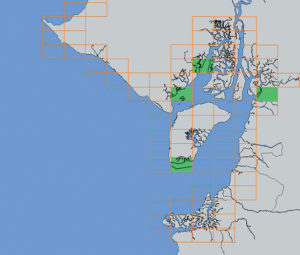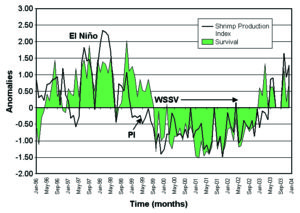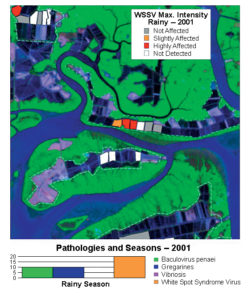Electronic charting and display system was initially driven by independent epidemiological criteria

During 1999, the shrimp-farming industry in Ecuador began experiencing heavy crop mortalities and severe economic losses due to the appearance of white spot syndrome virus (WSSV). Resource managers, academics and shrimp farmers quickly began to realize the need for monitoring programs to foresee future environmental and disease problems.
Monitoring campaigns were carried out to determine the spread and prevalence of WSSV and other shrimp diseases, but they were time-consuming and expensive. Concurrently, the Litoral Superior Polytechnic School (Escuela Superior Politécnica del Litoral, ESPOL), in collaboration with the Flemish University Council (VLIR), began developing an environmental management tool for aquaculture based on a geographic information system (GIS).
Geographic information systems are well suited to environmental and disease-monitoring programs because they provide a comprehensive analysis of spatial and temporal datasets in a cartographic form and allow database query and modeling at the same time. The ESPOL-VLIR GIS was devised to both determine the prevalence of WSSV and provide a scenario for the development of an epidemiological model that could alert shrimp farmers of future disease events.
GIS system
The system developed by ESPOL-VLIR consists of an electronic charting and display system that was initially driven by independent epidemiological criteria obtained from data analysis. However, the success of the epidemiological alert system would require continuous field campaigns to feed the GIS.
Farmers could regularly feed the geographic database on line by introducing their production variables after harvest through a Web site interface. A normalized production parameter was then developed to trigger alert levels in the 65, 13,000-ha cell grids built within the cartographic geographic system covering 107,000 ha of production area in the Gulf of Guayaquil.
Shrimp production index and anomalies
The shrimp production index (SPI) is a reference that combines production variables in the following equation:

The resulting SPI units are: 10 (grams per day) (grams per shrimp).

Departures of SPI values from their averages for a particular month and grid are measured in terms of anomalies as standard deviations from mean. This requires the normalization of SPI values by the subtraction of an SPI value from the average and division to standard deviation. One average and one standard deviation are obtained for each month in each grid. Each grid compiles the SPI values from farms contained in the grid.
The alert levels are triggered by changes in magnitude and sign in the monthly anomalies. Color criteria express the four alert levels, from green for anomalies greater than or equal to zero to red, which represents negative anomalies less than or equal to -0.25 the standard deviations.
Time series example
The SPI anomaly time series (1996-2003) for a participating shrimp farm is presented in Fig. 1. The survival anomaly is included in the same graph for comparison. Negative SPI anomalies were registered in late 1998 and early 1999 prior to the negative survival anomaly observed after May 1999. WSSV was officially recognized in Ecuador in April 1999.
Of interest are the negative SPI anomalies registered in January-May 1997 prior to El Niño, despite positive survival anomalies, and the June-July 1998 period, which coincided with negative survival anomalies. SPI and survival anomalies present the same negative pattern throughout the period of mid-1999 to 2003. Recovery of SPI values for this farm is evident in late 2003.
Electronic charting display

Land cartography from the Military Geographical Institute of Ecuador and satellite images were combined into a digitized geographic frame containing shrimp pond-positioning information distributed within corresponding grids of 12,860 ha each. Farm and pond density within each of the 65 grids varied depending on production location.
All production information from the different farms and ponds within the grid is used to calculate the SPI and its corresponding anomaly in the grid. Since SPI values are estimated from individual pond information, the alert system can be extended to ponds (Fig. 2).
The project’s future success will depend on the active participation of farmers in feeding their data into the database in a consistent and timely manner. A webpage to access information has already been created. The effort is now focused on a door-to-door campaign to involve farmers in this alert system.
(Editor’s Note: This article was originally published in the June 2004 print edition of the Global Aquaculture Advocate.)
Now that you've finished reading the article ...
… we hope you’ll consider supporting our mission to document the evolution of the global aquaculture industry and share our vast network of contributors’ expansive knowledge every week.
By becoming a Global Seafood Alliance member, you’re ensuring that all of the pre-competitive work we do through member benefits, resources and events can continue. Individual membership costs just $50 a year. GSA individual and corporate members receive complimentary access to a series of GOAL virtual events beginning in April. Join now.
Not a GSA member? Join us.
Authors
-
Stanislaus Sonnenholzner, Ph.D.
Centro Nacional de Acuicultura e Investigaciones Marinas
Campus Politécnico
Casilla 09-01-4519
Guayaquil, Ecuador -
Bonny Bayot, M.Sc.
Centro Nacional de Acuicultura e Investigaciones Marinas
Campus Politécnico
Casilla 09-01-4519
Guayaquil, Ecuador -
Ivan Apolo
Centro Nacional de Acuicultura e Investigaciones Marinas
Campus Politécnico
Casilla 09-01-4519
Guayaquil, Ecuador -
Teresa Vera
Centro Nacional de Acuicultura e Investigaciones Marinas
Campus Politécnico
Casilla 09-01-4519
Guayaquil, Ecuador -
Xavier Ochoa
Centro Nacional de Acuicultura e Investigaciones Marinas
Campus Politécnico
Casilla 09-01-4519
Guayaquil, Ecuador -
Zobeida Cisneros, Ph.D.
Centro Nacional de Acuicultura e Investigaciones Marinas
Campus Politécnico
Casilla 09-01-4519
Guayaquil, Ecuador -
Leo Van Biesen, Ph.D.
Centro Nacional de Acuicultura e Investigaciones Marinas
Campus Politécnico
Casilla 09-01-4519
Guayaquil, Ecuador -
M. Pilar Cornejo, Ph.D.
Centro Nacional de Acuicultura e Investigaciones Marinas
Campus Politécnico
Casilla 09-01-4519
Guayaquil, Ecuador -
Jorge Calderón, Ph.D.
Centro Nacional de Acuicultura e Investigaciones Marinas
Campus Politécnico
Casilla 09-01-4519
Guayaquil, Ecuador
Tagged With
Related Posts

Responsibility
A look at various intensive shrimp farming systems in Asia
The impact of diseases led some Asian shrimp farming countries to develop biofloc and recirculation aquaculture system (RAS) production technologies. Treating incoming water for culture operations and wastewater treatment are biosecurity measures for disease prevention and control.

Health & Welfare
A case for better shrimp nutrition
Shrimp farm performance can often be below realistic production standards. Use proven nutrition, feeds and feeding techniques to improve profitability.

Health & Welfare
A comprehensive look at the Proficiency Test for farmed shrimp
The University of Arizona Aquaculture Pathology Laboratory has carried out the Proficiency Test (PT) since 2005, with 300-plus diagnostic laboratories participating while improving their capabilities in the diagnosis of several shrimp pathogens.

Health & Welfare
A holistic management approach to EMS
Early Mortality Syndrome has devastated farmed shrimp in Asia and Latin America. With better understanding of the pathogen and the development and improvement of novel strategies, shrimp farmers are now able to better manage the disease.


